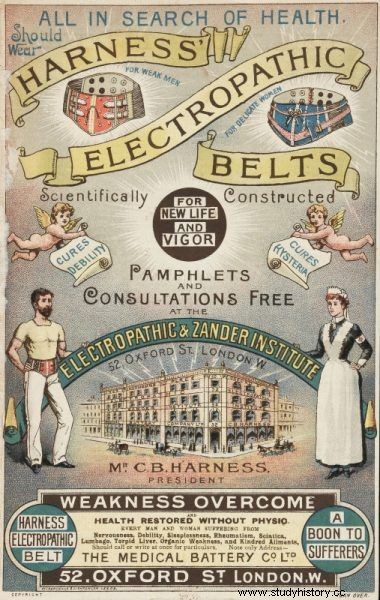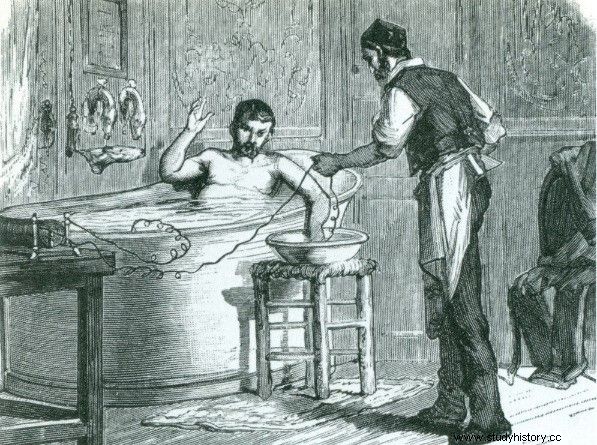One cold January day in 1803 in London, George Forster was hanged for murdering his wife and child. Apart from the fact that the criminal was sentenced to "death by hanging," his body was to be dissected as punishment extending to the afterlife, as it was widely believed that dismembered bodies were not to be resurrected on the Final Judgment. An additional surprise awaited Forster's body on its way to the grave:it was to attend a public demonstration in a new scientific field called galvanism, which uses electricity to stimulate muscles.
In the dark shadows of the walls of Newgate prison, Forster's body was handed over to Giovanni Aldini, an Italian physician who had a taste for theatrical macabre, who placed the body of a executed criminal in front of the assembled crowd and electrocuted it.
The Newgate Calendar - a cyclical chronicle of crimes committed by inmates of the famous prison - reported what followed:
As a result of the first application of the method to the face, the jaws of the dead criminal began to tremble, the adjacent muscles twisted excruciatingly, and one of the eyes opened. Later in the show, the deceased's right hand rose and squeezed. The legs, including thighs, were also set in motion.
The sight of Forster's corpse a moment previously executed, which suddenly began to twitch and quiver, caused such an enormous stir among viewers that many believed that Forster had been resurrected. Oauthentic fear of this possibility is evidenced by the fact that the course of the experiment was supervised by an executioner, ready at any moment to immediately hang Forster a second time, if the condemned man was indeed brought back to life by Aldini.

The article is an excerpt from the book Charlatans. The worst ideas in the history of medicine
From lightning to the lab
The phenomenon of electricity and its mystery intrigued mankind already in times when our ancestors fearfully admired the power of lightning. They also noticed that rubbed amber attracts hair and other light objects. They have witnessed a phenomenon known today as electrification, which is where a material creates an electric charge when it comes into contact with another object. Most of the electrostatic phenomena are caused by electrification - it results in, for example, when you take out clothes dryers that are stuck together. It was not until 1600 that William Gilbert, a courtier of Queen Elizabeth I, distinguished this phenomenon from magnetism (he managed to do without a clothes dryer) and coined the term "electricity" from the Greek word electron for amber.
Scientists took electricity seriously in the 18th century. The first Leiden bottles were created to solve the problem of storing electric charges. Probably everyone remembers the engraving of Benjamin Franklin flying with a fly against the stormy Philadelphia sky in 1752. In the footsteps of Franklin, the Italian physicist Alessandro Volta, who constructed the first electric battery, and Luigi Galvani (Giovanni Aldini's uncle), who discovered that the muscles of a dead frog twitch when struck by an electric spark . This experiment, carried out during a storm, consisted of hanging several pairs of frog legs cut off from the bodies on a metal railing. Galvani's neighbors must have been delighted with the inventive physician and his experiences.

Benjamin Franklin - Kite Experience
As Aldini regaled the crowds outside Newgate Prison with his macabre and shockingly unethical spectacle of the corpse of George Forster in the lead role, he also presented a real, highly significant, innovative scientific discovery. For the first time in history, mankind has tamed electricity to use it to manipulate the body.
In addition to the fact that galvanism was used to stimulate the corpses of frogs and criminals, it was eagerly used by doctors, electrified by the healing properties of the current. A contemporary of Galvani, Christian Gottlieb Kratzenstein began to experiment with the use of electricity for medical purposes:he treated patients suffering from rheumatism, malignant hyperthermia and juma with shock. He noticed that their heart rate increased when patients were subjected to electric shocks, and that he believed that it assisted the recovery process in some cases. He also observed that electricity somehow made patients feel tired. So he decided that this action could be beneficial for those for whom "wealth, worries and fears prevent a restful sleep at night". The next time you feel insomnia, just stick your finger in the wall socket - it's just a joke, absolutely don't.
In France, doctors began conducting experiments with electricity on paralyzed soldiers. In one of these experiments on December 26, 1747, a physician sparked sparks from a patient's paralyzed arm for two hours in the morning, and then again for two to three hours in the afternoon. As a result of such treatment, which lasted a month (!), The patient was cured of paralysis. The results of other experiments have not been so unequivocally positive, although there have been occasional spectacular successes, which, coupled with the widespread excitement about the mysterious process of electrification, have made, as one French physician stated, "everyone in this city wants to be electrified." It didn't take long for the charlatans to emerge willing to fulfill this wish.
Electric brushes, corsets and belts
Widespread enthusiasm for electricity was also spreading in America, where the electric good news was helped by various patented devices, such as electric brushes (for baldness!), Electric corsets (for slimming!) Or electric belts (for erectile dysfunction!). In lines resembling those in front of Apple showrooms on the day of the new iPhone's launch, people literally stumbled upon each other to purchase self-electrification devices. Technological innovations always cause excitement, and the atmosphere of excitement is fertile ground for quackery.
In 1880, a Dr. Scott introduced the electric hairbrush to the market, which quickly became a huge hit in America. The handle of the electric hairbrush Dr. Scott had a magnetized rod, but the device had no power. It was simply a moderately magnetized hairbrush - but by advertising it in such an unattractive way, the manufacturer would not win over a multitude of potential buyers. Scott, a marketing genius, used a phenomenon incomprehensible to the masses driven by sheep rush to make quite a fortune.

Electric belts to heal male powerlessness and female hysteria. Healthy, scientific, discreet and supposedly boastful. 1890s ad (Wellcome Library collection).
As the country was long and the American press filled with advertisements for Scott's product, which claimed that the electric brush would free the user from problems, not only directly related to hair loss, such as alopecia or migraines, but also save him - here the logic takes it - from lameness , paralysis and constipation. Scott was distributing his brushes with a warning that guaranteed him more sales while fueling family quarrels: It is imperative that only one person is using the brush. Only a brush that is always used by the same person retains its full healing powers ” .
Over time, Scott expanded his non-electric electric empire by starting corset production. Like his hairbrushes, Scott's "electric" corsets were only slightly magnetized. Touted as "indestructible" - the thought of squeezing the human body into a "indestructible" corset gives chills - the corsets also promised to heal an incredible multitude of diseases. They could also, when "worn continuously", act as "balancing factors in severe obesity or excessively thinness by managing odic forces in accordance with the laws of Nature."
However, not only women were able to enjoy the health benefits of electricity. The men were given electric belts.

The article is an excerpt from the book Charlatans. The worst ideas in the history of medicine
Time to welcome Pulvermacher. By the end of the 19th century, many wealthy men of fashion owned a Pulvermacher. This word, which would be a great name for a German death metal band, was abbreviated as Pulvermacher's Electric Belt - the crème de la crème of electric belts at the turn of the century. The electric belts released "gentle continuous currents" throughout their life, and the recommended duration was eight to twelve hours a day. In addition to the belts, Galvanic Company Pulvermacher (with the US headquarters in San Francisco Galvanic Division) produced a range of electric chains that could be attached to almost any part of the body.
The enthusiasm of the electric belt wearers has been commemorated in the literature. Homais, one of the characters in the novel by Gustave Flaubert's Lady Bovary, has been described as an enthusiast of "Pulvermacher's hydroelectric chains; he wore one himself; And in the evening, when he was taking off his flannel vest, Mrs. Homais was dazzled before the golden scrolls under which he was dying, and felt the flame of her feelings for this man, bound like a Scythian and as magnificent as a magician, burst out with redoubled force. "
Pulvermacher belts, which contained zinc and copper, and required soaking in vinegar before use, did indeed produce a weak electric current by taking advantage of the current produced by the human body (so in fact, the belts could be called "galvanic" belts). The current was felt enough to convince the user that the belt or chain was actually working.
This certainty also beat the haughty marketing campaign of the Pulvermacher Enterprise, which filled its advertisements with the slogan "Electricity is life", filled with lengthy recommendations from prominent doctors. The problem is that Enterprise Pulvermacher has never really received the endorsement of any reputable specialist, and the appeals to its products have been made up.
Electric belts were of course advertised as universal remedies for kidney, stomach, liver and intestinal ailments, especially dyspepsia. Special models of belts were designed to stimulate the penis using the magic powers of galvanic current. Producers exploited the common fear in the late 19th century that a man had a certain amount of sperm to distribute throughout his life. Masturbation practiced in adolescence was blamed for subsequent erectile dysfunction. Fortunately, this problem could be remedied:an electric shock to a tired aging penis would instantly restore it to its former glory days.
How about a mix of electricity and water?
Those who were not satisfied with the operation of corsets and belts, could go a little further and be tempted to bathe in a velectric bathtub. Contrary to the well-known and reasonable rule that water should not be brought into contact with electricity, the actions of supporters of the use of electricity in curling contributed to the creation in the nineteenth century of electric baths, also known as "galvanic" baths. One of such establishments - the Therapeutic and Electrical Institute - was founded by Jennie Kidd Trout, a Canadian, who was the first in her country's history to be licensed to practice medicine, which she deserved to be commemorated on a Canadian postage stamp. The institute founded by Trout in Toronto in 1875 owned six baths. Patients immersed body parts or their entire bodies in metal-covered tubs filled with warm water. They then kept the electrodes (thankfully not immersed in water) attached to the battery, which electrified the water with a low current. Basically it was just a jacuzzi but filled with energized water.
It is worth noting that Trout, who also ran a free clinic for the poor, was not a charlatan and did not go so far as to deceptively tout the effectiveness of her treatments. Like many other doctors of the time, she sincerely believed that electric baths help her patients:electricity was supposed to stimulate the work of internal organs and blood circulation, aglow water "open the pores of the skin" and induce sweating to cleanse the body of toxins. Electric bathing has been touted as a method of providing relief to people suffering from a variety of chronic diseases such as rheumatism, gout and sciatica.

Electric baths have become a real hit!
Although electric baths are no longer mainstream treatments, they are still practiced in the medical community. Quite recently, in 1989, the Vanity Fair magazine caused a stir, reporting that British Prime Minister Margaret Thatcher was regularly taking electric baths as part of a complex set of health and beauty treatments. The prime minister was visiting "a certain Indian woman" who reportedly cared for the good condition of "the most powerful woman in the world". Thatcher paid over £ 600 for her specialized 0.3 amp bath in electrified water.
British tabloids were overwhelmed by the news of this revelation, printing articles with sedative titles:"Plugged in by the Indian guru - Maggie's bathing secrets" or "The amazing secret of the electric prime minister".
Did the electric baths work? This was to be expected when paying £ 600 for the procedure.
Though there is no scientific evidence to support the rejuvenating effects of electric baths, at the end of the Iron Lady's political career, tabloids speculated endlessly about her increasingly younger appearance over the years. It can therefore be speculated that it was due either to electric baths or to the natural vigor unleashed in the process of dismantling the welfare state and ruining the social security system.

The article is an excerpt from the book "Szarlatani. The worst ideas in the history of medicine ”
Electricity today
Although electric baths, belts and corsets are long forgotten, the 20th century brought many recognized electrical devices, including an electrocardiograph, an EKG device that records the electrical activity of the heart. Electricity is also used by orthopedists to promote bone healing and by cardiologists to regulate the heart rhythm with pacemakers. And let's not forget the defibrillator, who has saved countless lives over the years by energizing their hearts with electroshock.
This is how the medical community concluded a truce with electricity. Anam remains nostalgic to reflect on the times of Pulvermacher's innovative products. Just think that in these old serious photos, New York businessmen are hiding softly humming electric belts under layers of old-fashioned clothing.
Either way, it's a much nicer thought than the memory of a corpse dancing under the scaffold outside Newgate Prison.
The article is an excerpt from the book "Charlatans. The worst ideas in the history of medicine ”published by the Jagiellonian University.
